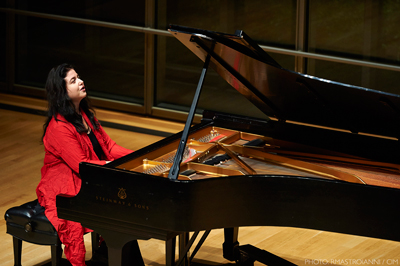by Daniel Hathaway

Auerbach, who grew up in the Ural mountains on the borders of Siberia, then trained at Juilliard, is an artistic polymath. She writes poetry and prose, paints, and composes prolifically. Prolifically and obsessively, judging from her three sets of 24 preludes, first for piano, subsequently for violin and piano and cello and piano. She couldn’t get that project out of her mind.
Auerbach prefaced her performance of the solo piano preludes with her own description of the pieces, which last about 45 minutes. They are “throwaway ideas” of “fragile beauty” that “disappear quickly”. She liked the idea of arranging a series of evanescent miniatures into a grand form — a plan she also followed with the other two sets.
Time passes quickly as you immerse yourself in Auerbach’s narrative journey through a succession of evocative scenes often interrupted by changes of mood or disasters. There are whispers of classical forms and procedures — French overtures, ostinatos, fugues, toccatas, arias — and now and again some hints of Russia — a balalaika, church bells, a peasant dance. But nothing stays very long and there’s no opportunity for boredom. Auerbach was an eloquent interpreter of her own fertile ideas. She played brilliantly and even added a new voice to one prelude as she hummed a tune against dissonant chords.
Changing her costume for part two, Lera Auerbach spoke to the audience about her take on the role of the composer/virtuoso — a performer who has respect for the music she plays, but approaches the text with liberty and a sense of adventure. She also noted that Mussorgsky’s Pictures is one of the most-transcribed pieces in history: there are some fifty orchestrations in addition to the best-known version by Ravel. In this piece, the piano, she said, is capable of suggesting — not mimicing — the sound of other instruments, and the work as a whole has elements of both the partita and the theme and variations form. She also spoke about the role of the Promenades, which seem to change with the moods induced by the paintings the observer has just viewed.
The first promenade was heavily cloaked in pedal, suggesting the sound of clanging bells and giving the audience a clue about Auerbach’s creative approach to her interpretation of Mussorgsky’s score. Inner voices came to the foreground in “The Old Castle”. The children in the Tuileries seemed to be having a real, hair-pulling fight. The ox cart in “Bydlo” was never so slow and ponderous. The “Ballet of the Unhatched Chicks” was awkward and heavy-footed. As the piece drew to a conclusion in “Baba-Yaga” and “The Great Gate of Kiev,” Auerbach’s playing became gloriously, devil-may-care messy. And powerfully thrilling. The audience — especially the students who whooped and hollered afterwards — ate it up. Auerbach was called back for not one, but three encores.
The “Return of the Composer/Virtuoso” series continues on October 30 with violinist Mark O’Connor, on January 23 with pianist Gabriela Montero, and on February 21 with composer/singer/performer Meredith Monk. All performances are in Mixon Hall at CIM except that of October 30 which takes place in Gartner Auditorium at the Cleveland Museum of Art, a co-presentation between CIM and CMA’s Masters of the Violin series. Tickets are required for all the evenings.
Photos by Roger Mastroianni courtesy of CIM.
Published on ClevelandClassical.com September 24, 2013
Clickhere for a printable version of this article.



